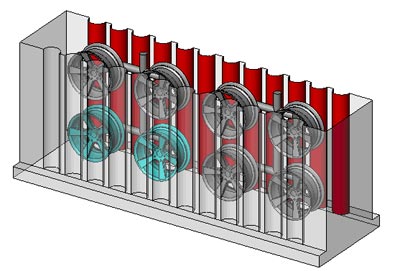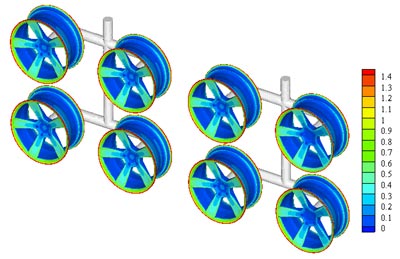|
Outline
ELSYCA CP-MASTER Simulation of a CP System for Buried TankELSYCA PLATINGMASTER Copper Plating of Non-uniformly Patterned Wafer Gold Wafer Plating Process in a Cupplater Decorative Cr plating process for a rack of wheels Bipolar Pulsed Simulation of a Cu Plating Process Cr Plating Process for a Rack of Shower Tap Parts Acid Zn Plating Process for a Brake CaliperDOWNLOAD Download Studies as pdf |
DECORATIVE CR PLATING PROCESS FOR A RACK OF WHEELSTitle: Simulation of a decorative Cr plating process for a rack of wheels Bath Type: Decorative chromic acid Cr (VI) Applied software tool: Elsyca PlatingMaster Industry: Automotive Validity and Reliability: Correlation between simulated and measured layer thickness values is well above 80% Goal of Simulations: Drastically speed up rack design Customer Benefits: Productivity improvements, time & cost savings Description: Decorative Cr plating processes produce highly non-uniform current density and layer thickness distributions. Rack design by trial-and-error will often require huge labour costs, mainly due to the large number of adjustable configuration parameters: number of parts in the rack, orientation and position of the parts, shape, dimension and position of screens and/or current thieves, etc. An entire trial and error run (rack design - rack manufacturing - plating - measuring layer thickness distributions on some parts in the rack) might take easily one week or longer. In contrast, defining the rack configuration from figure 1 in the SolidWorks CAD environment takes only a few hours, with another 1 or 2 hours to compute the resulting layer thickness distribution (figure 2) with Elsyca PlatingMaster. Hence, using Elsyca PlatingMaster will dramatically reduce the number of experimental trial and error runs, saving precious money and time. 
Figure 1: Rack configuration with load of 8 wheels and surrounding plating tank walls; Top surface represents the electrolyte level, front and back surface represent anode baskets. 
Figure 2: Layer thickness distribution (in micron) over all wheels in the rack. |
Rose Consulting Engineers LimitedWe are an independent provider of computational fluid dynamic (CFD) flow modelling services to all manufacturing sectors and are the UKs only authorised reseller/partner of Elsyca electrochemical simulation software |
|
|
|
|
|
|
|
|
![[IMAGE] Site Location](../img/case.gif)